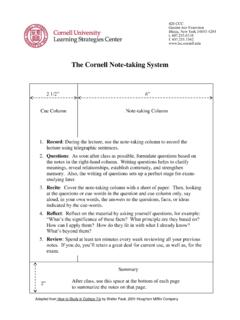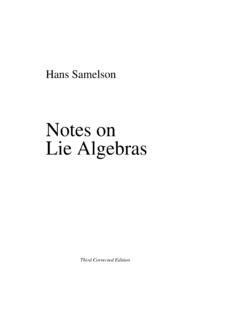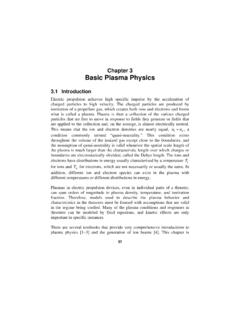Transcription of Pattern Recognition and Machine Learning
1 Christopher M. BishopPattern Recognition andMachine LearningChristopher M. Bishop DirectorMicrosoft Research LtdCambridge CB3 0FB, cmbishopSeries EditorsMichael JordanDepartment of ComputerScience and Departmentof StatisticsUniversity of California,BerkeleyBerkeley, CA 94720 USAP rofessor Jon KleinbergDepartment of ComputerScienceCornell UniversityIthaca, NY 14853 USAB ernhard Scho lkopfMax Planck Institute forBiological CyberneticsSpemannstrasse 3872076 Tu bingenGermanyLibrary of Congress Control Number: 2006922522 ISBN-10: 0-387-31073-8 ISBN-13: 978-0387-31073-2 Printed on acid-free paper.
2 2006 Springer Science+Business Media, LLCAll rights reserved. This work may not be translated or copied in whole or in part without the written permission of the publisher(Springer Science+Business Media, LLC, 233 Spring Street, New York, NY 10013, USA), except for brief excerpts in connectionwith reviews or scholarly analysis. Use in connection with any form of information storage and retrieval, electronic adaptation,computer software, or by similar or dissimilar methodology now known or hereafter developed is use in this publication of trade names, trademarks, service marks, and similar terms, even if they are not identified as such,is not to be taken as an expression of opinion as to whether or not they are subject to proprietary in Singapore.
3 (KYO) book is dedicated to my family:Jenna, Mark, and HughTotal eclipse of the sun, Antalya, Turkey, 29 March Recognition has its origins in engineering, whereas Machine Learning grewout of computer science. However, these activities can be viewed as two facets ofthe same field, and together they have undergone substantial development over thepast ten years. In particular, Bayesian methods have grown from a specialist niche tobecome mainstream, while graphical models have emerged as a general frameworkfor describing and applying probabilistic models. Also, the practical applicability ofBayesian methods has been greatly enhanced through the development of a range ofapproximate inference algorithms such as variational Bayes and expectation propa-gation.
4 Similarly, new models based on kernels have had significant impact on bothalgorithms and new textbook reflects these recent developments while providing a compre-hensive introduction to the fields of Pattern Recognition and Machine Learning . It isaimed at advanced undergraduates or first year PhD students, as well as researchersand practitioners, and assumes no previous knowledge of Pattern Recognition or ma-chine Learning concepts. Knowledge of multivariate calculus and basic linear algebrais required, and some familiarity with probabilities would be helpful though not es-sential as the book includes a self-contained introduction to basic probability this book has broad scope, it is impossible to provide a complete list ofreferences, and in particular no attempt has been made to provide accurate historicalattribution of ideas.
5 Instead, the aim has been to give references that offer greaterdetail than is possible here and that hopefully provide entry points into what, in somecases, is a very extensive literature. For this reason, the references are often to morerecent textbooks and review articles rather than to original book is supported by a great deal of additional material, including lectureslides as well as the complete set of figures used in the book, and the reader isencouraged to visit the book web site for the latest information: cmbishop/PRML viiviiiPREFACEE xercisesThe exercises that appear at the end of every chapter form an important com-ponent of the book.
6 Each exercise has been carefully chosen to reinforce conceptsexplained in the text or to develop and generalize them in significant ways, and eachis graded according to difficulty ranging from( ), which denotes a simple exercisetaking a few minutes to complete, through to( ), which denotes a significantlymore complex has been difficult to know to what extent these solutions should be madewidely available. Those engaged in self study will find worked solutions very ben-eficial, whereas many course tutors request that solutions be available only via thepublisher so that the exercises may be used in class.
7 In order to try to meet theseconflicting requirements, those exercises that help amplify key points in the text, orthat fill in important details, have solutions that are available as a PDF file from thebook web site. Such exercises are denoted bywww. Solutions for the remainingexercises are available to course tutors by contacting the publisher (contact detailsare given on the book web site). Readers are strongly encouraged to work throughthe exercises unaided, and to turn to the solutions only as this book focuses on concepts and principles, in a taught course thestudents should ideally have the opportunity to experiment with some of the keyalgorithms using appropriate data sets.
8 A companion volume (Bishop and Nabney,2008) will deal with practical aspects of Pattern Recognition and Machine Learning ,and will be accompanied by Matlab software implementing most of the algorithmsdiscussed in this of all I would like to express my sincere thanks to Markus Svens en whohas provided immense help with preparation of figures and with the typesetting ofthe book in LATEX. His assistance has been am very grateful to Microsoft Research for providing a highly stimulating re-search environment and for giving me the freedom to write this book (the views andopinions expressed in this book, however, are my own and are therefore not neces-sarily the same as those of Microsoft or its affiliates).
9 Springer has provided excellent support throughout the final stages of prepara-tion of this book, and I would like to thank my commissioning editor John Kimmelfor his support and professionalism, as well as Joseph Piliero for his help in design-ing the cover and the text format and MaryAnn Brickner for her numerous contribu-tions during the production phase. The inspiration for the cover design came from adiscussion with Antonio also wish to thank Oxford University Press for permission to reproduce ex-cerpts from an earlier textbook,Neural Networks for Pattern Recognition (Bishop,1995a).
10 The images of the Mark 1 perceptron and of Frank Rosenblatt are repro-duced with the permission of Arvin Calspan Advanced Technology Center. I wouldalso like to thank Asela Gunawardana for plotting the spectrogram in Figure ,and Bernhard Sch olkopf for permission to use his kernel PCA code to plot Fig-ure people have helped by proofreading draft material and providing com-ments and suggestions, including Shivani Agarwal, C edric Archambeau, Arik Azran,Andrew Blake, Hakan Cevikalp, Michael Fourman, Brendan Frey, Zoubin Ghahra-mani, Thore Graepel, Katherine Heller, Ralf Herbrich, Geoffrey Hinton, Adam Jo-hansen, Matthew Johnson, Michael Jordan, Eva Kalyvianaki, Anitha Kannan, JuliaLasserre, David Liu.




